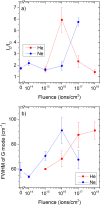Defect formation in multiwalled carbon nanotubes under low-energy He and Ne ion irradiation
- PMID: 30116687
- PMCID: PMC6071685
- DOI: 10.3762/bjnano.9.186
Defect formation in multiwalled carbon nanotubes under low-energy He and Ne ion irradiation
Abstract
The mechanical, structural, electronic and magnetic properties of carbon nanotubes can be modified by electron or ion irradiation. In this work we used 25 keV He+ and Ne+ ion irradiation to study the influence of fluence and sample thickness on the irradiation-induced damage of multiwalled carbon nanotubes (MWCNTs). The irradiated areas have been characterised by correlative Raman spectroscopy and TEM imaging. In order to preclude the Raman contribution coming from the amorphous carbon support of typical TEM grids, a new methodology involving Raman inactive Au TEM grids was developed. The experimental results have been compared to SDTRIMSP simulations. Due to the small thickness of the MWCNTs, sputtering has been observed for the top and bottom side of the samples. Depending on thickness and ion species, the sputter yield is significantly higher for the bottom than the top side. For He+ and Ne+ irradiation, damage formation evolves differently, with a change in the trend of the ratio of D to G peak in the Raman spectra being observed for He+ but not for Ne+. This can be attributed to differences in stopping power and sputter behaviour.
Keywords: Raman; carbon nanotubes; helium ion microscope; ion irradiation; simulations.
Figures








References
-
- Lehman J H, Terrones M, Mansfield E, Hurst K E, Meunier V. Carbon. 2011;49:2581–2602. doi: 10.1016/j.carbon.2011.03.028. - DOI
-
- Sammalkorpi M, Krasheninnikov A, Kuronen A, Nordlund K, Kaski K. Phys Rev B. 2004;70:245416. doi: 10.1103/PhysRevB.70.245416. - DOI
-
- Huhtala M, Krasheninnikov A V, Aittoniemi J, Stuart S J, Nordlund K, Kaski K. Phys Rev B. 2004;70:45404. doi: 10.1103/PhysRevB.70.045404. - DOI
LinkOut - more resources
Full Text Sources
Other Literature Sources
